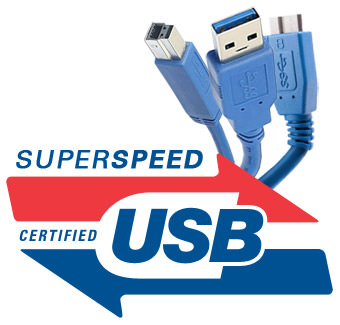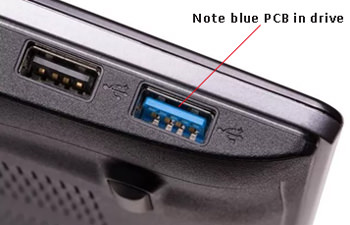USB 3.0 FAQ
You may have seen the term USB 3.0 in the headlines or popping up in the specifications of some of your latest technology products, but what exactly is USB 3.0? Premium USB is here to tell you all the basics!
A little bit of background…
USB 3.0, also known as SuperSpeed USB, is the most recent generation of Universal Serial Bus (USB) technology developed by Intel. It connects data between our peripherals (mice, keyboards, monitors, printers, speakers, cameras, flash drives, etc.) to our computers through USB ports and cables.
Currently, the mainstream interface is USB 2.0, but USB 3.0 is gaining support and adoption thanks to its distinct advantages. The USB Implementers Forum (USB-IF) oversees the specifications and certifications of SuperSpeed hardware and devices.

The benefits of USB 3.0…
USB 3.0 is designed to accommodate our increasing demand for larger amounts of digital storage and bandwidth. By doubling the four connection wires of USB 2.0 to eight wires, USB 3.0 allows for the unprecedented bidirectional transfer of data. As a result of its engineering, USB 3.0 also:
- Transfers data up to ten times faster than USB 2.0 (theoretically 4.8 Gbps)
- Operates with more energy efficiency since it uses host signaling and power management as opposed to constantly polling for data
- Provides a quicker, more potent boost in bus power to devices that demand more like smartphones, hard drives, etc.
USB 3.0's compatibility…
Before you try and toss all of your existing devices and hardware, USB 3.0 was designed to be backward compatible by maintaining the same physical 2.0 connection while adding new wires and folds that only come into play when a 3.0 connection is made. What that means is that USB 3.0 ports can accept USB 2.0 cables.
Your current USB 2.0 devices can be plugged into a SuperSpeed port. USB 3.0 devices are also compatible with USB 2.0 ports, but as a result, will only operate at 2.0 speeds. Either way, USB 3.0 blends with what you already own. To achieve SuperSpeed in data transfers, make sure you have a USB 3.0 controller or controller card.
Most new computers are coming out with 3.0 USB ports, they function with both 3.0 and 2.0 drives. Good news is that USB drives are cross compatible, you can use either type of drive in either port type - but to get the fastest throughput you need a 3.0 drive in a 3.0 port.
Check to see if you have USB 3.0 ports, just look at the USB ports themselves, they are normally colored blue inside. Many computers have both USB 2.0 and USB 3.0 ports. In the below photo, the port on the left is USB 2.0 and the port on the right is USB 3.0.

USB 3.0 in our future…
Please call us for pricing and availability of select USB 3.0 drives. More SuperSpeed offerings are just around the corner for us. Once native support in motherboards, adapter cards and devices increases, we'll be even further equipped to provide you with more custom USB 3.0 flash drive choices at prices that are affordable and fair to you.
